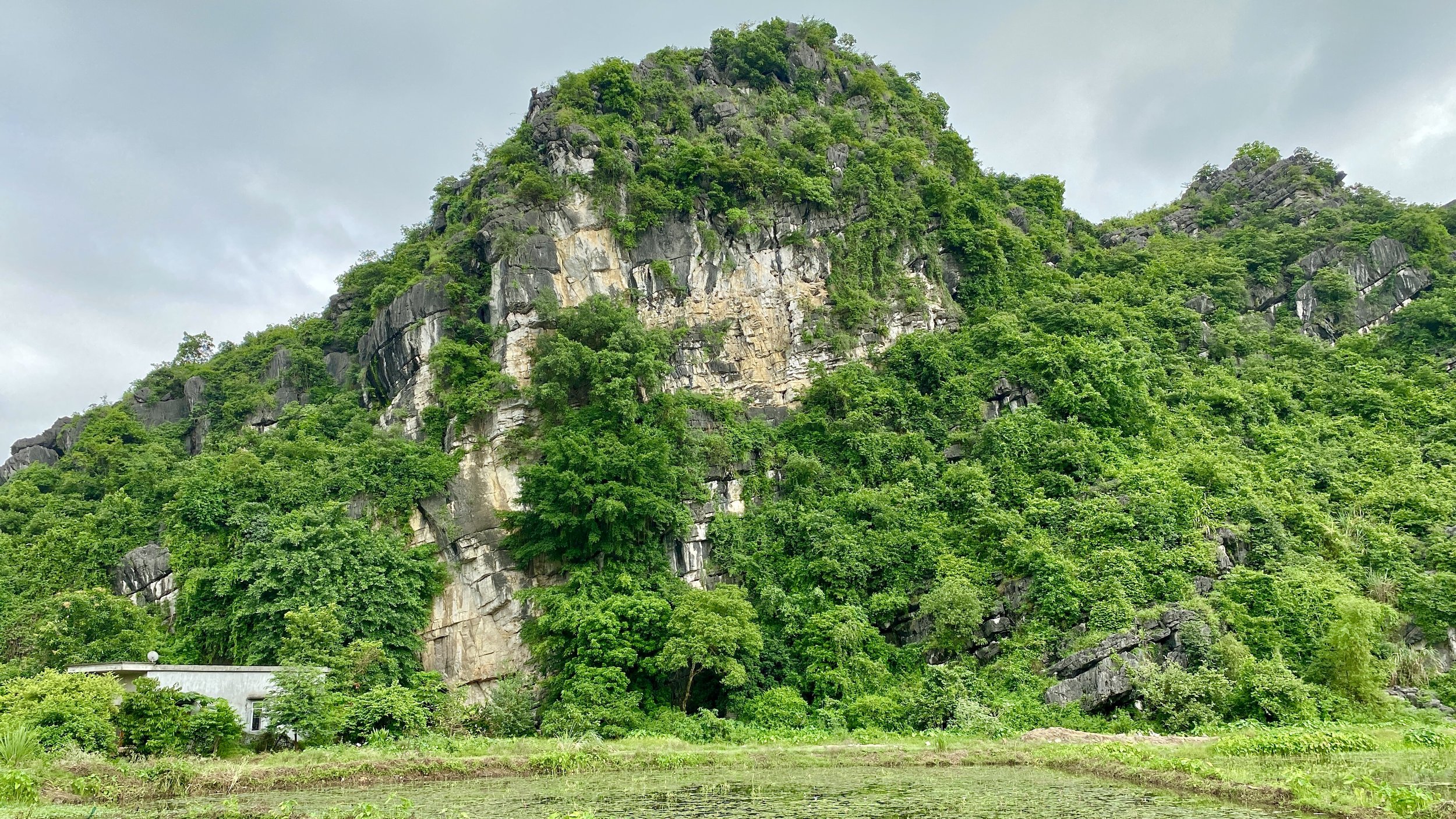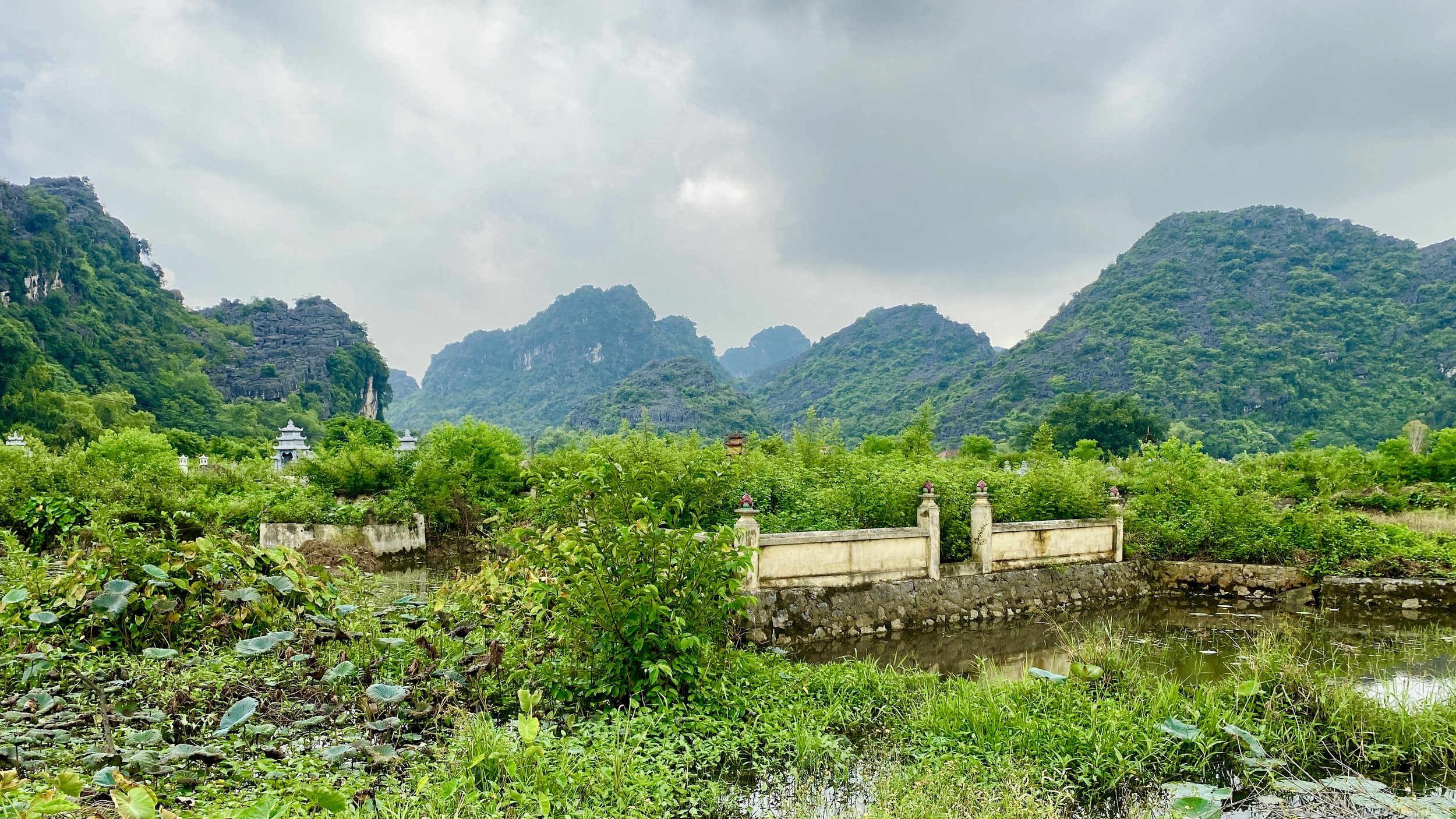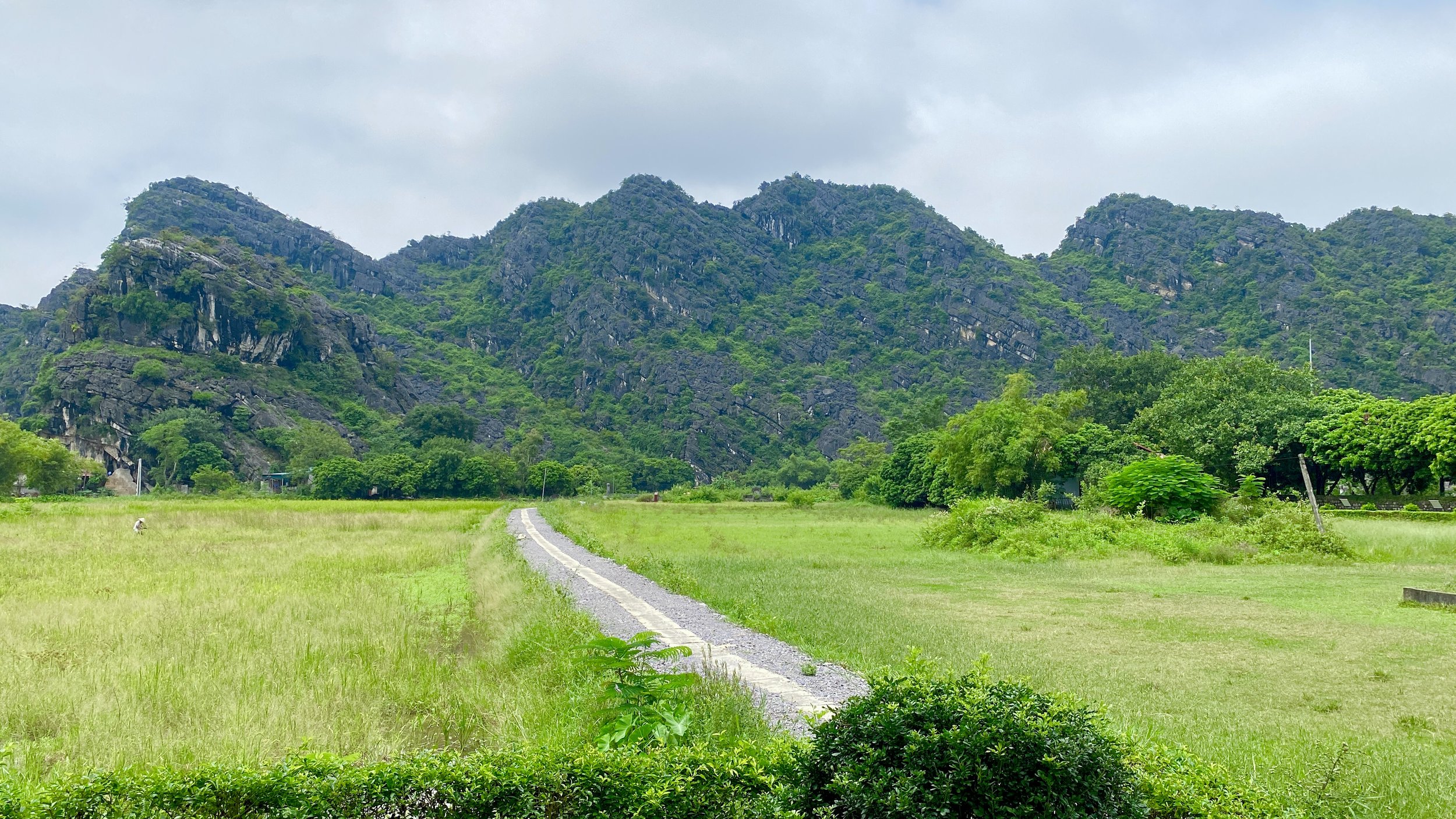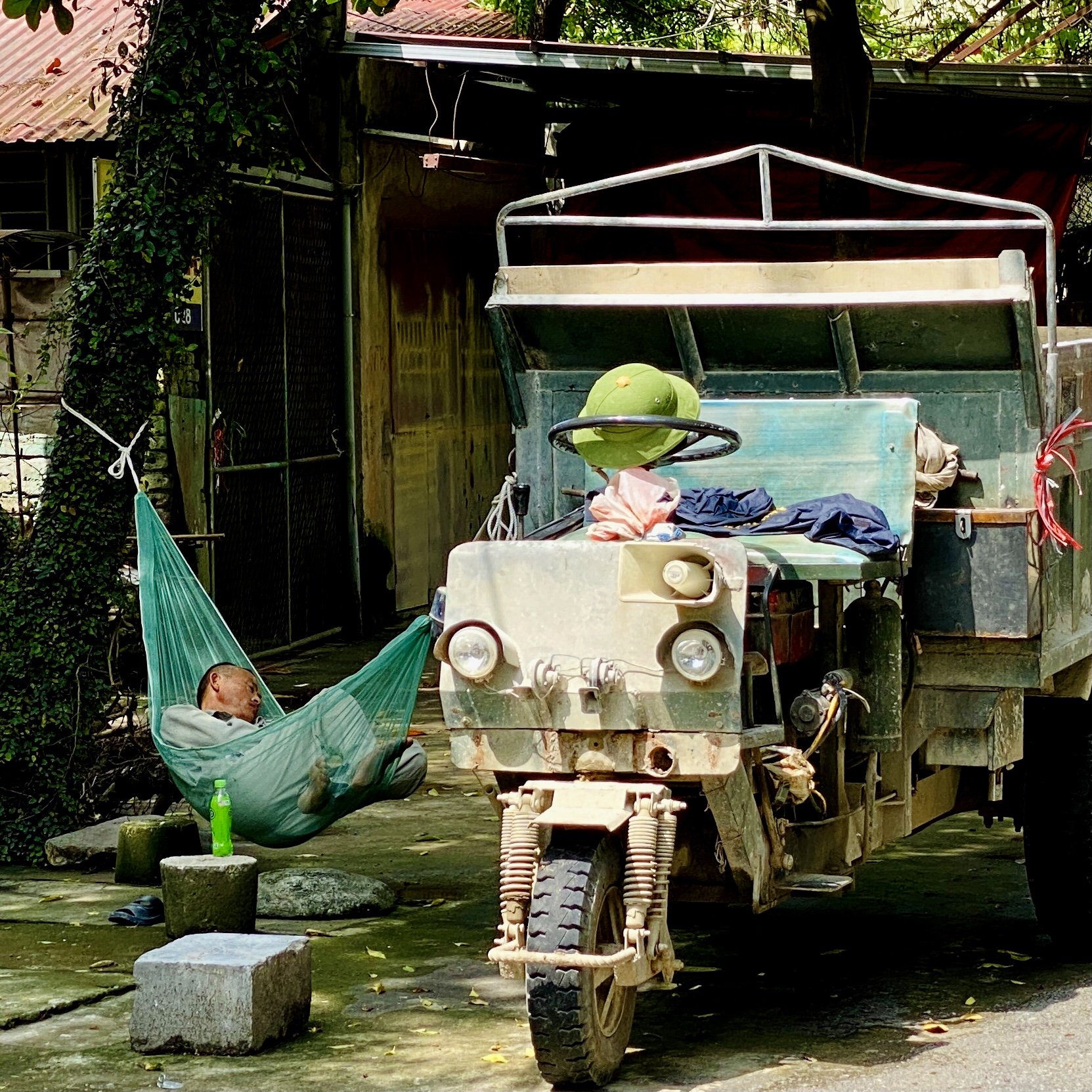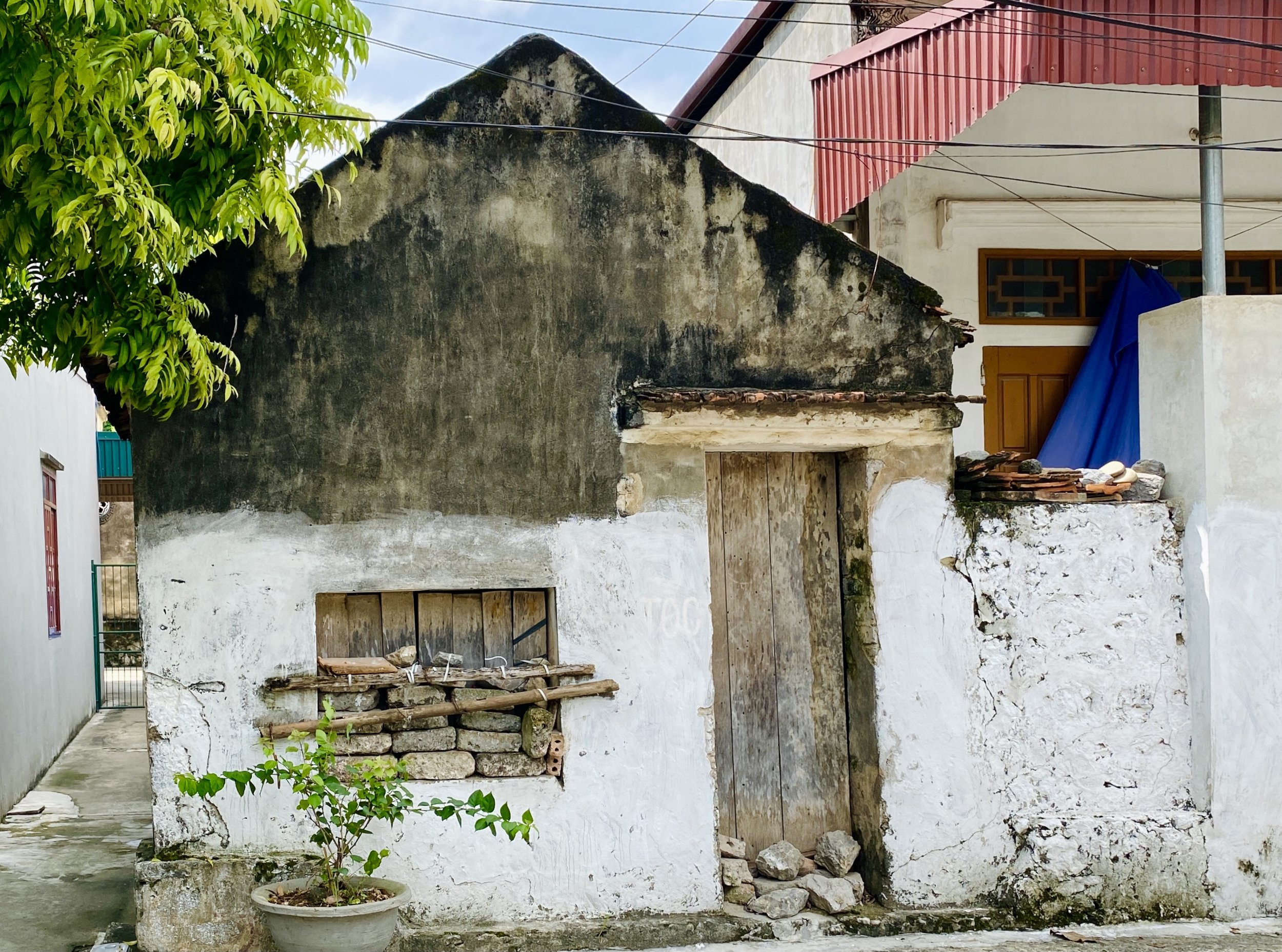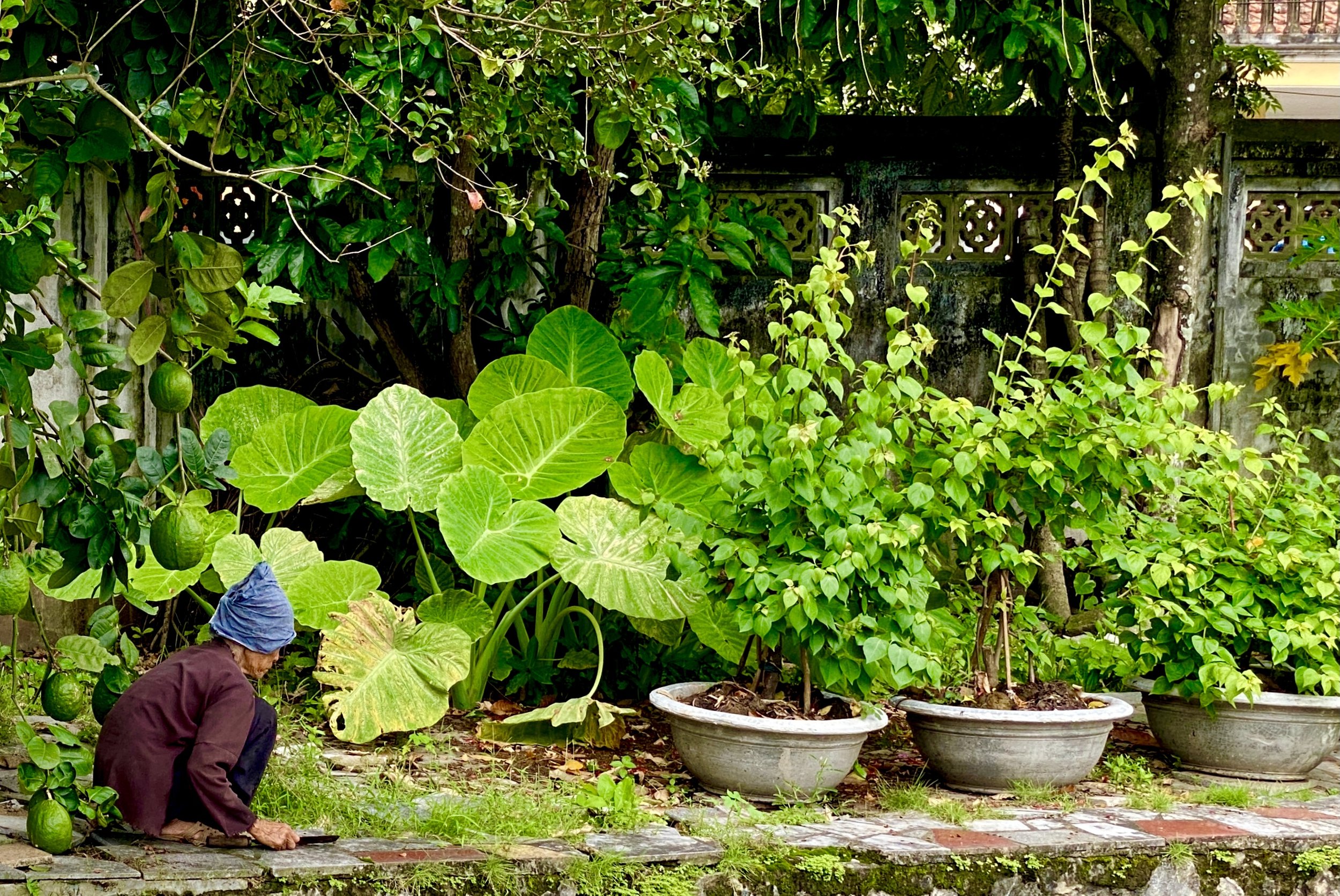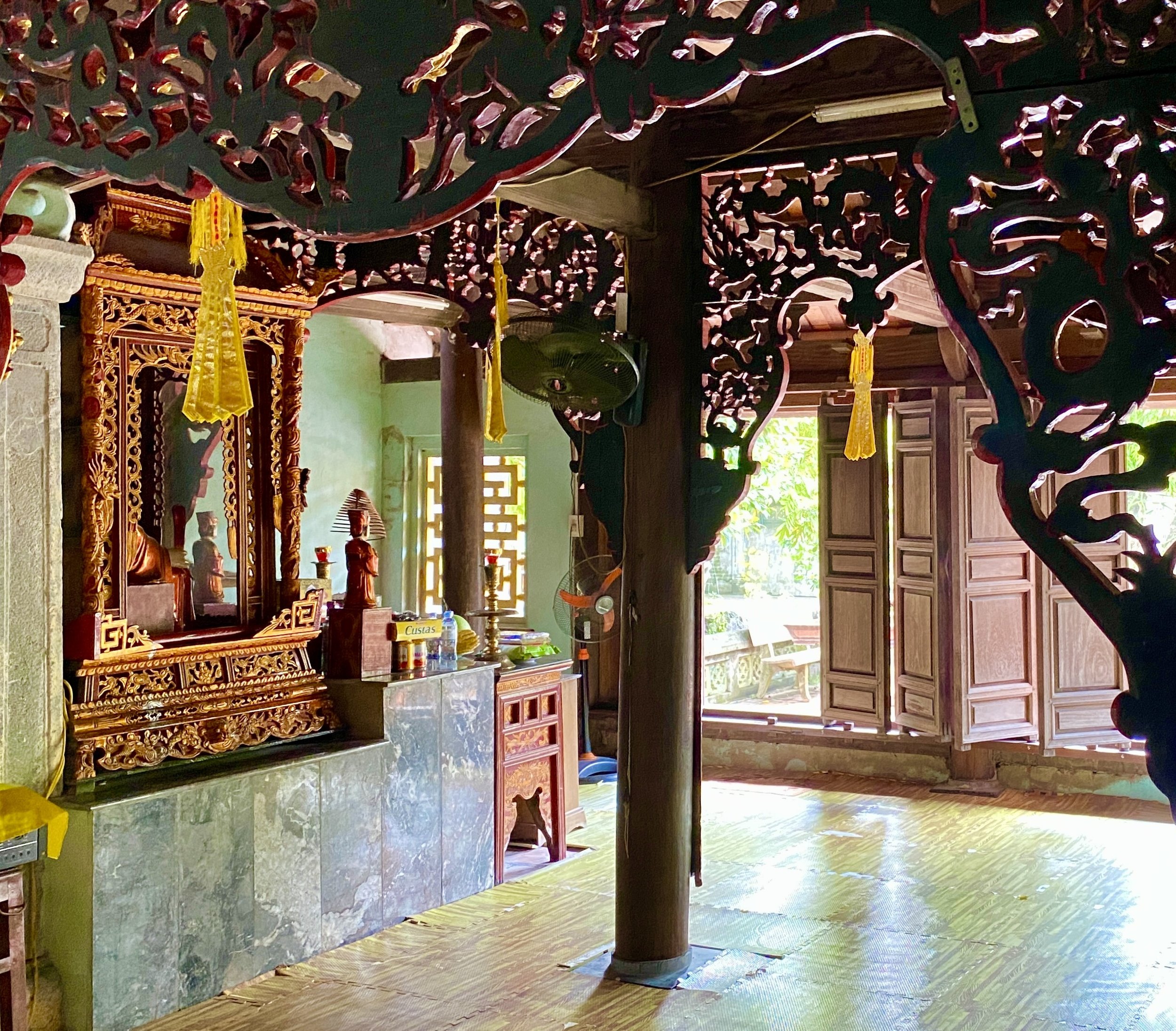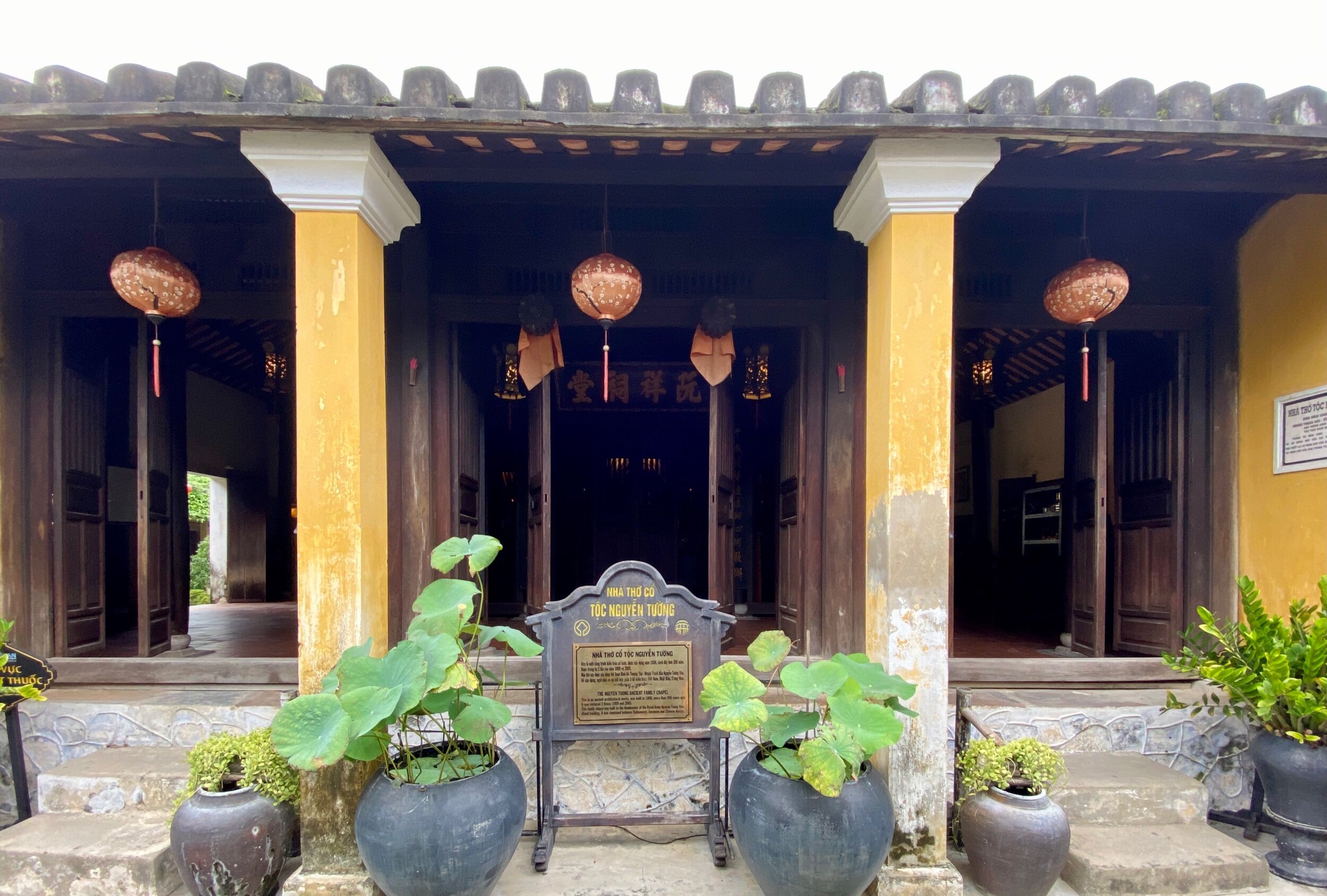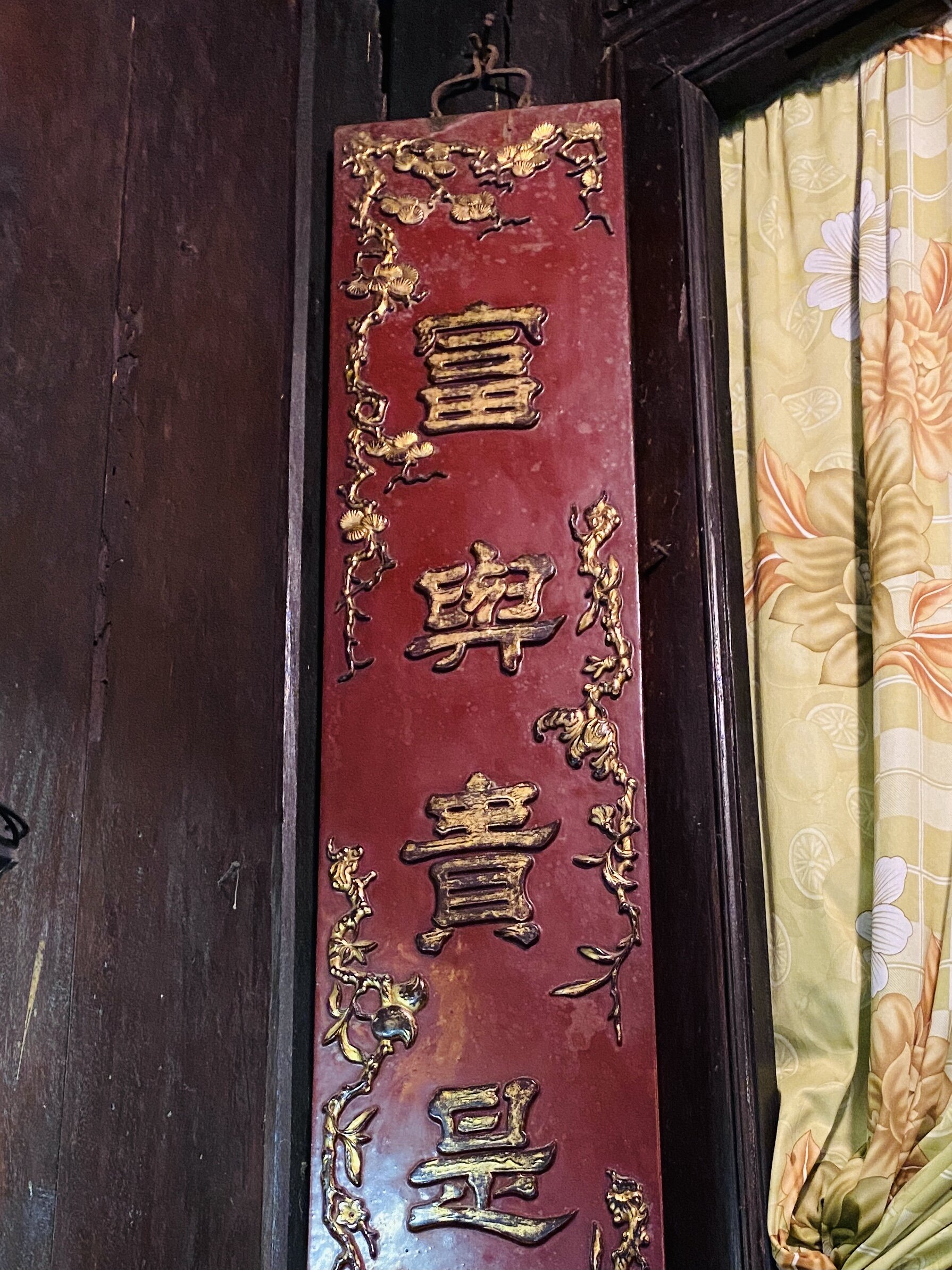I love seeing the sights everywhere I go, but in a place like Ninh Binh, it’s sometimes just as enjoyable to see the non-sights. A walk in the countryside is such a relief for mind and body.
Nhat Tru Pagoda, Ninh Binh | Vietnam
Walking through the gate from the Hoa Lu memorial temples into a small village, it’s only a few hundred feet before you hit Nhat Tru pagoda off to the right. The village itself itself is quite picturesque, though there are no amenities like convenience stores, and the odd old lady will attack you trying to sell incense or fans.
The temple consists of heavily renovated late 18th and early 19th century structures, respectfully built by the then-reigning Nguyen dynasty in the Dinh architectural style (what they believed 10th century structures would look like). In this style there are 5 main buildings: the Tien Duong (main lobby), Thuong Dien (Buddha Worship house), ancestor worship house, guest house, and tower (along with odd outbuildings for gardening and such).
The centerpiece of the temple is the ancient Buddhist pillar, erected in 995 by King Le Dai Hanh, and inscribed with the Surangama sutra. Notable for its rare lotus finial, the pillar is (dare I say) quite phallic; the main themes of the sutra are the impotence of dharma (righteousness) when unaccompanied by samadhi (the power of devotional trance) and the importance of confronting delusions in meditation.
There was actually a pagoda here prior to the erection of the pillar. After running away with a court official and regretfully returning, a Dinh princess was punished by being committed here as a nun. Upon her father’s assassination in 979, she committed suicide by throwing herself into the well (still in use) and there’s a small temple devoted to her in the complex also. How long does it take to carve a Buddhist pillar like this? 15 years? Could this possibly be an artifact of low-key sexist shade? I wonder if there was even a personal beef between them?
The last relic of interest here is the bronze temple bell cast in 1799. It is inscribed: “Do good and you will meet hundreds of good things … good people are always happy, this is the law of cause and effect “.
Hoa Lu Ancient Capital, Ninh Binh | Vietnam
The first independent (from the Southern Han Chinese) Vietnamese dynasty was founded by Đinh Bộ Lĩnh, the victorious warlord, in his hometown of Hoa Lư in 968. His dynasty only lasted 11 years; after he and his heir were murdered by a palace official, his most powerful military commander Lê Hoàn at first became regent to his remaining six year old son, but shortly dethroned the boy to rule as the first Early Lê dynasty emperor.
The Early Lê dynasty didn’t last much longer. Lê Hoàn ruled peacefully for 25 years, but his five sons warred over the throne for over a year after his death, massacring whole towns and murdering each other in the process. The eventual winner, Lê Long Đĩnh, was so notoriously debauched that he’s considered the Emperor Nero of Vietnam. Between his orgies and his hemorrhoids, he’s derisively referred to in ancient literature as ‘the emperor lying on the throne’ (as opposed to sitting on it). He mysteriously died after ruling for only 4 years; the high ranking mandarin and aristocrat who replaced him, Lý Công Uẩn, simply convinced the court to avoid any more Lê family infighting. Lý Công Uẩn founded the Lý dynasty in 1009, and moved the capital to what is now Hanoi, an auspicious site within a day’s ride of his own hometown.
So, Hoa Lu was only a preeminent city for 40 years. Modern structures have been built on the locations of the ancient buildings and tombs. There is nothing to be seen from the 10th or 11th centuries save a few artifacts in a small museum room in the Lê King temple. It is still a nice place to walk or relax for an hour or two. There is a local festival held to honor the ‘2 Kings’ in years ending in three, five, eight and zero, either on the 15th of the second lunar month (considered the birthday of Dinh Tien Hoang King) or on the eighth and thirteenth day of the lunar third month. I wasn’t there during the festival so it’s up to you to decode those dates and figure out if they’re worth timing your visit for!
Thung Nham Bird Sanctuary, Ninh Binh | Vietnam
Thung Nham Bird Sanctuary is just a 15 minute drive from Tam Coc village, and a very scenic/peaceful place for walking or biking. I visited one afternoon and barely saw any birds; I was told by other visitors they fly out in the mornings and come back around 5PM, so my timing was bad.
There is an entry fee; there’s also a “luxury hotel” in the middle of the park if you feel like paying $70+/night for the same scenery available elsewhere for $20. The park is more or less a single circuit; there are three caves at the beginning of the route; a lookout point and tiny island mid park, and a steep trail to an ancient tree about 3/4 of the way around. There are no guides.
The caves weren’t particularly scenic; one you practically have to crawl through, and another is lit throughout with irritating colored lights. The entrance to the trail towards the ancient tree isn’t clear; I couldn’t find it and there was no one to guide me so I didn’t see it. Unless they mean the giant banyan near the little temple?
I spent around 2 hours here, that’s how long it took me to wander around at a leisurely pace. It’s a nice half-day of exercise in nature, but not a must-see.
Bich Dong Pagoda, Ninh Binh | Vietnam
Bich Dong Pagoda dates from the 18th century, and features a pre-Nguyen dynasty architectural style. It’s built into a mountainside at three levels, and some shrines are inside dark caves. The steps make it easy to navigate and the views are beautiful; it was not possible for me to do them justice in photos because there’s a lot of greenery blocking them, the main perspective is almost straight up.
Word of warning: Tam Coc has the most aggressive hawkers I’ve encountered in Vietnam, and I’ve been here for two years now. The old women who sell fruit and souvenirs will literally run ahead of you and lock up the temples if you don’t buy from them. $2-6 is enough to pay for a folding fan and some bananas, come armed with small bills.
Tam Coc Boat Tour, Ninh Binh | Vietnam
The Tam Coc boat ride is the most popular in Ninh Binh, because one of the entry points is steps from Tam Coc’s main corner, where restaurants, hotels, minimarts etc. converge. It’s lovely, but shorter and not as interesting as the Trang An boat tour. Tam Coc is also known for having much more aggressive guides, who will essentially refuse to bring you back to shore unless you give them a $20 or $30ish tip on top of the ticket price. The ‘galaxy grotto’ is awful in my opinion; they’ve lit the cave with brightly colored lights, many flashing or swirling.
Múa Viewpoint, Ninh Binh | Vietnam
There’s not a lot to say about the Mua viewpoint, it’s just a beautiful view to reward you for about an hour and a half of exercise. It’s only accessible through the Hang Múa Ecolodge, and they charge you a couple bucks as an entrance fee. Once you’re in, they have various kiosks where you can buy drinks or ice cream, and little ponds and statue gardens where you can instagram it up, if that’s your thing.
Trang An Boat Tour, Ninh Binh | Vietnam
Though every village in Ninh Binh seems to have a boat tour, the best by far is the Trang An tour. There are 3 routes; all feature at least a couple caves and temples, and the beautiful mountain scenery of course. Each has its own merits. I chose Route 1, wanting to see the thousand year old temple. It’s so altered there’s nothing old there, so don’t expect much. Route 2 visits the King Kong movie set. They give you a map and time to choose when you buy the ticket, which is quite pricy.
An alternative to the boat tour is renting a kayak and going self-guided. I wish I had done this, because the guides don’t speak English and I didn’t learn anything, and was stuck on a boat with a woman who just wouldn’t shut up. I would have much preferred a few hours of exercise and some peaceful time in nature. There are so many professional guides rowing people around, a solo or duo kayaker could easily follow them along a route and not get lost.
There’s also a small museum in the ticket office with artifacts found in the area. It has some fossils, prehistoric stuff, bat trang pottery, etc.
Three Old Houses in Hoi An: Đức An, Phùng Hủng, and Nguyễn Tường | Vietnam
Đức An
The old house of Duc An was built around 1850, but the family who lives here is one of the founding families of Hoi An; their original house was built on the property in the mid 1600s. In the late 19th century the house operated the most famous bookshop in central Vietnam, selling both traditional Chinese and Vietnamese texts and the work of foreign philosophers like Voltaire and Rousseau; like many famous bookstores, it also served as a meeting place for local intelligentsia and anti-colonial activists, including Phan Chu Trinh. As anti—French sentiment rose and was persecuted more strictly in the 20th century, the “bookstore” operation was moved to the back, and the (literal and figurative) front was a Chinese medicine dispensary. The house transitioned from being a gathering place for revolutionaries to one for communists, and there are many pictures and medals from party luminaries on display. Only the front room of the front house is open for guests.
Phùng Hủng
Phuong Hung means ‘expectations of good business’, and its builder was a trader in precious woods, spices and ceramics. The family has been there for 8 generations, and the architecture of the house is wonderful, featuring one of the largest vaulted ceiling and internal balconies. I don’t have the best photos because I visited during Covid and after a flood, but there are some youtube videos that show the space well.
Nguyễn Tường
The Nguyen Tuong family chapel was built in 1806, about 50 years earlier than the other famous old houses of Hoi An. The layout is in the Hue style rather than the local style, as it was built by a military leader gifted the land by then Emperor Minh Mang. However, it still incorporates the local blend of Japanese and Chinese architectural styles. Later generations changed the main house into a family chapel, and now live in connected smaller houses. There were two famous writers in the family, and a noted artist in the current generation who sells his work in their small shop.
The Old House of Tan Ky, Hoi An | Vietnam
Built in 1741, the old house of Tan Ky is a grand example of the traditional merchant houses of Hoi An, arising at the zenith of the town’s importance as a commercial port. It incorporates elements of traditional Vietnamese, Chinese, and Japanese wooden houses.
Japanese influence shows in the main roof of the front house, constructed in the triangular five rafter style, and the layout of connected small rooms that can either be shuttered or left open to form a larger space. The tubular townhouse design, with two story front and back houses, divided by a courtyard, and opening onto parallel streets, is uniquely Vietnamese. And of course, the whole place was constructed by local Kim Bong carpenters.
The paneled ceilings of the small halls are in the Chinese crabshell style. The “two swords” decorative rafters on the side walls are also Chinese, as are the yin-yang roof tiles. There are many symbolic carvings throughout, including pumpkins (fertility), ribbons (10,000), batwings (good luck, especially in finance), a lute with ribbons (harmony in marriage), protective “eyes”, and clouds (the mode of transport of the gods) among others. A specialist in Chinese decorative arts could spend hours or days here deciphering everything; there are artistic references to generational continuity, material prosperity, marital harmony, Buddhism and Confucianism.
In addition to the architectural details, there are hundreds of valuable antiques to study. These are mostly the personal effects and treasured belongings of the ancestors of the home’s current occupants. Tan Ky means “great progress”; the founding patriarch, Le Tan Ky, earned the honorific by beginning life as a neighborhood orphan named Cong, and becoming one of the richest traders in the city. He purchased the house around 1850, and it has remained in the family for seven generations so far. Currently the family lives upstairs, and downstairs is a house museum. Small antiques are displayed in cases and larger furniture and objects are left where they’ve always been.
Of the many antiques, the two most famous are the Hundred Birds panels and the Confucius cup. The Hundred Birds panels depict 100 Chinese characters as unique mother of pearl birds inlaid in lacquer. In traditional Chinese art, the Hundred Birds motif symbolizes fame, mastery, perfection and leadership. And of course, any sailor knows that seeing birds means your long voyage is all but over.
The Confucius cup is from the 16th century, and demonstrates a story wherein Confucius (thirsty after roaming a desert) was given a special cup of water that emptied itself when filled to the brim, but held water when only partially filled. The lesson is about not getting too greedy, and not letting the desire to be great overrule the habit of being good.
The back house is open to the Hoai river. There are old manual rice hullers, stoves and other items once used by servants, plus parking for the family’s scooters. There’s also a dumb waiter to the second floor, once used to haul down purchases from an upstairs warehouse, for loading onto waiting boats.
Hoi An has always flooded in the winter, and some years are worse than others. Locals like to nostalgically mark the water height in these years, the same way some parents mark their children’s height and age on a door frame. It seems the flooding in the old town has become much worse since the 1990s, when the island opposite the old town was built out. The worst year recorded at Tan Ky house is 1964, but the remaining 8 catastrophic floods were all between 1999 and 2017.
Of all the old houses in Hoi An, this one is absolutely the best. I could have spent much more time eyeing their antiques. I would go back!



